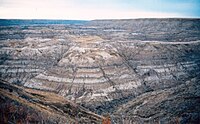
Back Eonoteem Afrikaans طبقة دهر Arabic Эанатэма Byelorussian Eonotem (geologija) BS Eratema Spanish Ladem Estonian چینهابردوران Persian Éonothème French Eonotema Italian Эонотема Kazakh


In stratigraphy and geology, an eonothem is the totality of rock strata laid down in the stratigraphic record deposited during a certain eon of the continuous geologic timescale. The eonothem is not to be confused with the eon itself, which is a corresponding division of geologic time spanning a specific number of (hundreds of millions of) years, during which rocks were formed that are classified within the eonothem. Eonothems have the same names as their corresponding eons, which means during the history of the Earth only four eonothems were formed. Oldest to newest these are the Hadean, Archean, Proterozoic, and Phanerozoic. A rock stratum, fossil or feature present in the "upper Phanerozoic" eonothem would therefore have originated within the "later Phanerozoic" eon. In practice, the rock column is discontinuous:
Technically, a complete geologic record doesn't occur anywhere. For such a record to develop would require the area to have been receiving sedimentary deposits continually ever since the origin of the earth. Nowhere is such a situation known to exist. If it did exist, we could not effectively look at the strata because they would still be buried, and modern strata would continue to be deposited on top of them. The earth's surface has been far too dynamic to allow that to occur anywhere. No area has been in such a static condition throughout the earth's long history. Areas that have had sediment deposited on them at one time are later uplifted and eroded. In some places this has occurred many times. There is ample evidence to prove such a sequence of events.[1]
Eonothems, despite discontinuities (locally missing strata or unconformities), can be compared to others where the rock record is more complete and, by correlation of points of correspondence, be fixed appropriately within the eon. They are therefore useful as broad chronostratigraphic units, specifying approximate age within the timelines within the rock column.
Eonothems are subdivided into erathems and their smaller subdivisions within geology and paleobiology and their sub-fields, and a whole system of cross-disciplinary classification by strata is in place with oversight by the International Commission on Stratigraphy.
Eonothems are not often used in practice as expert dating estimates can be and usually are specified into the more refined timelines of smaller chronostratigraphic units, which can be subdivided in turn down to the many defined stages, the smallest formally recognised units used in dating. (see the hierarchy of comparative units, five each for time division types and five for the rock record types.)
- ^ Richard Burky, ©1990 by the Worldwide Church of God. "An Overview of the Geologic Record". Retrieved 2008-06-21.
{{cite web}}: CS1 maint: numeric names: authors list (link)